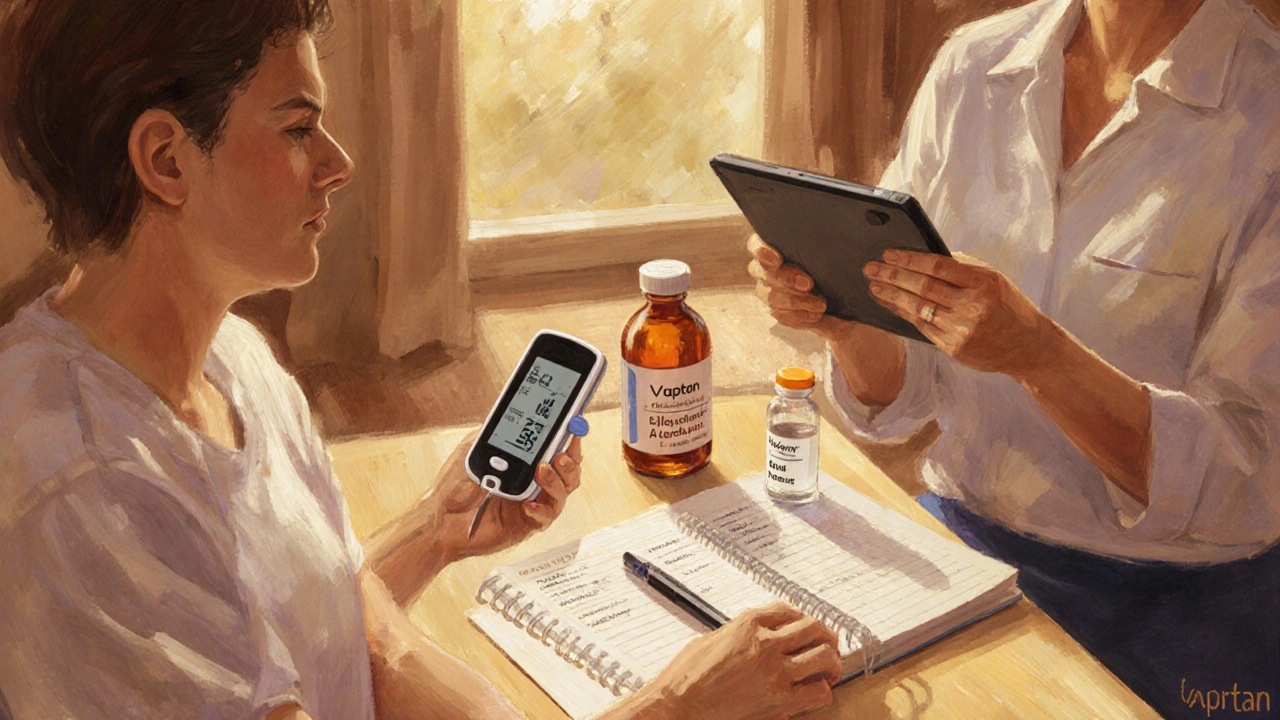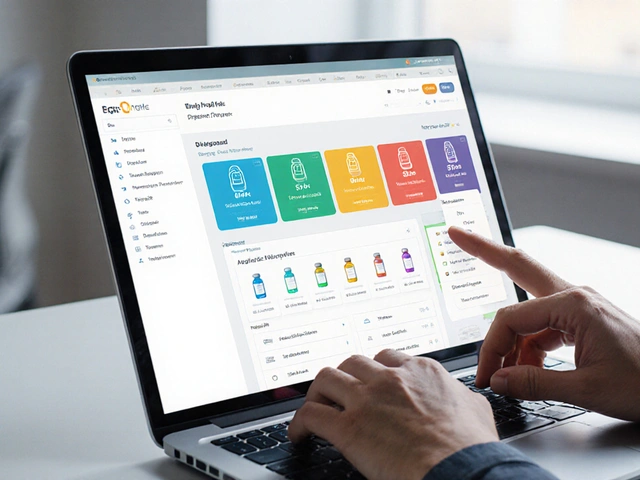
Hyponatremia Risk Calculator for Diabetics
Enter your details and click "Assess Hyponatremia Risk" to get your personalized risk assessment.
Key Takeaways
- Hyponatremia (low blood sodium) is more common in people with diabetes because high blood sugar can pull water into the bloodstream.
- Both hyperglycemia‑induced osmotic diuresis and certain diabetes meds can trigger or worsen low sodium levels.
- Recognising symptoms early - nausea, headache, confusion - can prevent serious complications.
- Treatment focuses on correcting the underlying glucose problem, adjusting fluids, and sometimes using medication to control water balance.
- Regular monitoring of sodium and glucose helps keep both conditions in check.
When you hear the terms hyponatremia and diabetes, you might picture two unrelated health issues. In reality, they often intertwine in subtle ways that can catch patients and clinicians off guard. This article breaks down why low sodium shows up more often in people with diabetes, how the two conditions feed each other, and what practical steps you can take to stay ahead of problems.
Understanding the Basics
Hyponatremia is a condition where blood sodium concentration falls below 135mmol/L. Sodium helps regulate fluid balance, nerve signals, and muscle function. When levels dip, water shifts into cells, causing swelling that can affect the brain.
Diabetes mellitus is a chronic disease characterized by high blood glucose due to insufficient insulin production or action. Elevated glucose pulls water out of cells, leading to frequent urination and dehydration if not managed.
At first glance, one deals with a salt deficit and the other with a sugar excess, but the body’s fluid system ties them together tightly.
How High Blood Sugar Lowers Sodium
When glucose climbs above 180mg/dL, the kidneys can’t reabsorb all of it. The excess glucose stays in the filtrate, and water follows by osmosis - a process called osmotic diuresis (increased urine output caused by solutes like glucose drawing water into the urine).
More urine means you lose both water and electrolytes, especially sodium. If you replace the fluid loss with water alone (common with over‑the‑counter sports drinks or plain water), you dilute the remaining sodium, pushing you toward hyponatremia.
In addition, high glucose raises plasma osmolality, which suppresses the release of antidiuretic hormone (ADH) (a hormone that tells the kidneys to retain water). Paradoxically, the body may release too much ADH in response to perceived dehydration, trapping water inside blood vessels and further diluting sodium.
Diabetes Medications that Influence Sodium Balance
Not all sugar‑lowering drugs are neutral to sodium. Here are the most common culprits:
- Thiazide diuretics (medications that increase urine sodium loss), often prescribed for hypertension in diabetics, can directly drop sodium levels.
- SGLT2 inhibitors (drugs that force the kidneys to excrete glucose in urine) cause a mild, chronic osmotic diuresis and may lead to volume depletion and low sodium.
- High‑dose insulin (the hormone that moves glucose into cells, also pulling potassium and sodium into cells) can shift sodium intracellularly, lowering serum levels.
Awareness of these effects lets clinicians adjust doses or add sodium‑rich fluids when needed.
Risk Factors that Make Diabetics Susceptible
Even if you’re diligent about glucose, some personal factors raise the odds of hyponatremia:
- Age over 65 - kidneys lose concentrating ability, making fluid balance fragile.
- Kidney disease - impaired filtration amplifies the impact of osmotic diuresis.
- Excessive fluid intake - marathon runners, hot‑weather workers, or anyone drinking large volumes of plain water without electrolytes.
- Concurrent illnesses - infections, vomiting, or diarrhea can both raise glucose and deplete sodium.
These factors often overlap, creating a perfect storm for low sodium in diabetics.
Symptoms to Watch For
Because the brain is especially sensitive to swelling, neurological signs are the earliest red flags:
- Headache that doesn’t improve with usual painkillers
- Nausea or vomiting without an obvious cause
- Confusion, difficulty concentrating, or sudden mood changes
- Muscle cramps or weakness
Severe hyponatremia can lead to seizures or coma. If you or a loved one with diabetes experiences these, seek medical care right away.

Diagnostic Approach
Doctors start with a basic blood panel:
- Serum sodium (mmol/L) - the primary marker.
- Serum glucose - to see if hyperglycemia is contributing.
- Serum osmolality - helps differentiate true hyponatremia from dilutional effects of glucose.
- Urine sodium and glucose - high urine glucose confirms osmotic diuresis.
When sodium is low and glucose is high, the corrected sodium (adjusted for glucose) can reveal the underlying deficit. The formula is: Corrected Na = Measured Na + 0.016 × (Glucose‑100), where glucose is in mg/dL.
Management Strategies
Tailoring treatment to the root cause is key. Below is a practical roadmap:
| Scenario | Primary Action | Additional Tips |
|---|---|---|
| Hyperglycemia‑driven osmotic diuresis | Rapid glucose control (insulin pump or IV insulin) | Monitor sodium every 4‑6hrs; replace fluids with balanced electrolyte solutions. |
| Medication‑induced sodium loss (e.g., thiazides) | Adjust or pause diuretic; add sodium‑rich diet or oral rehydration salts. | Check renal function before making changes. |
| Excessive water intake | Limit free water; encourage drinks with 70mmol/L sodium. | Educate on safe hydration during exercise or hot weather. |
| Severe symptomatic hyponatremia | IV hypertonic saline (3% NaCl) under cardiac monitoring. | Raise sodium no faster than 8mmol/L in 24hrs to avoid osmotic demyelination. |
In mild cases, simply correcting glucose and ensuring adequate salt intake may resolve the problem in 24‑48hours. For chronic hyponatremia, a low‑dose oral vaptan (an ADH‑receptor antagonist that promotes free water excretion without losing sodium) can be considered, though cost and liver safety should be discussed.
Prevention Tips You Can Use Today
- Check blood sugar and sodium at least quarterly if you have type1 or type2 diabetes.
- When sick with fever or vomiting, measure urine output; aim for at least 0.5mL/kg/hr.
- Include moderate salt (around 1500mg) in meals if you’re on a low‑sodium diet but prone to hyponatremia.
- Limit plain water during intense workouts; use sports drinks that contain electrolytes.
- Review your medication list with a pharmacist; ask whether any drug may affect sodium.
Small habits add up. By keeping an eye on both glucose and electrolytes, you stay ahead of the chain reaction that leads to low sodium.
Frequently Asked Questions
Can hyponatremia cause high blood sugar?
Low sodium itself doesn’t raise glucose, but severe hyponatremia can stress the body, leading to a surge of stress hormones like cortisol, which may push blood sugar up temporarily.
Is drinking sports drinks enough to prevent hyponatremia?
Sports drinks help because they contain sodium and carbohydrate, but they’re not a cure‑all. In diabetics, the sugar content can spike glucose, so choose low‑calorie, electrolyte‑focused formulas or add a pinch of salt to water.
How fast should sodium be corrected?
Safety guidelines recommend raising serum sodium no more than 8mmol/L in the first 24hours and no more than 18mmol/L in 48hours to avoid brain injury.
Do all diabetes types have the same hyponatremia risk?
Type1 often experiences rapid glucose swings, leading to more frequent osmotic diuresis, while type2 patients may be on diuretics for hypertension, which also lowers sodium. Both groups are at risk, just via slightly different pathways.
Can I test my sodium level at home?
Over‑the‑counter kits exist but are less accurate than lab tests. If you suspect hyponatremia, a blood draw at a clinic is the reliable route.
Understanding the link between hyponatremia and diabetes empowers you to catch problems early, adjust treatment, and keep both blood sugar and electrolytes in a healthy range. Stay curious, track your numbers, and work with your healthcare team - those simple steps can make a big difference.





Shana Shapiro '19
October 11, 2025 AT 15:16Understanding how low sodium intertwines with diabetes feels like untangling a delicate tapestry; the stakes are high, especially for those already navigating glucose swings. Keeping an eye on both numbers can prevent the hidden danger of brain swelling and the subtle fatigue that often goes unnoticed. I urge anyone managing diabetes to pair their glucose logs with regular electrolyte checks, even when they feel fine. Simple steps like adding a pinch of salt to meals or choosing electrolyte‑rich beverages can make a dramatic difference in comfort and safety. Remember, early awareness is the most compassionate gift you can give yourself.
Jillian Bell
October 12, 2025 AT 19:03What many fail to see is the coordinated push by big‑pharma to obscure the link between popular SGLT2 drugs and hidden sodium loss. Every new trial headline conveniently omits the subtle rise in hyponatremia cases, steering clinicians toward glossy marketing instead of hard truth. The hidden agenda keeps patients dependent on costly medications while the real electrolyte danger slides under the radar. Wake up to the fact that the system benefits from muddled information, and demand transparent data before trusting any prescription.
Lindsey Bollig
October 13, 2025 AT 22:50Hey folks, the good news is that you don’t have to live in fear of hyponatremia – a few practical tweaks can keep you safe. Start by tracking your water intake alongside carbs; if you’re drinking a lot of plain water, swap in a sports drink that has sodium and a modest sugar boost. Pair that with regular glucose checks and you’ll catch any drift before it spirals. Keep the mood light, stay consistent, and you’ll stay ahead of the curve.
Daniel Buchanan
October 15, 2025 AT 02:36Let’s look at this together: if you’re over 65 and on thiazides, adjust your salt intake gradually while monitoring blood pressure. A gentle reminder to involve your healthcare team ensures that changes are safe and personalized. Sharing experiences in a supportive community can also highlight strategies that work for different lifestyles.
Lena Williams
October 16, 2025 AT 06:23so omg i was reading about how glucose pulls water into your bloodstream and i thought wow that’s like a hidden trap lol but then i realized if you chug a gallon of water after a high‑sugar snack you’re basically watering down your sodium and that can sneak up on you. also, the thing about thiazide diuretics is they’re sneaky-they just keep pulling sodium out while you think you’re doing fine. i guess the take away is keep an eye on both numbers, not just the sugar, and maybe add a little salty snack if you’re drinking a ton of water. just my two cents.
Sierra Bagstad
October 17, 2025 AT 10:10From a physiological standpoint, hyperglycemia raises plasma osmolality, prompting osmotic diuresis that expels both water and sodium. The resulting hypovolemia stimulates antidiuretic hormone release, which further dilutes serum sodium. Consequently, the corrected sodium calculation – measured Na + 0.016 × (glucose − 100) – is essential for accurate assessment. Monitoring this parameter alongside fasting glucose provides a comprehensive picture of fluid‑electrolyte balance.
Alan Kogosowski
October 18, 2025 AT 13:56When blood glucose spikes above the renal threshold, glucose molecules spill into the tubular fluid and act as an osmotic agent, dragging water along and producing an osmotic diuresis. This increased urine flow not only depletes body water but also carries a substantial load of sodium and potassium, thereby lowering serum electrolyte concentrations. The kidneys attempt to compensate by reabsorbing water under the influence of antidiuretic hormone, yet the simultaneous loss of solutes prevents full correction of the sodium deficit. Over time, repeated episodes of hyperglycemia can lead to a chronic state of relative hyponatremia, especially in patients who do not replace sodium-rich fluids. Moreover, certain antihyperglycemic agents, such as SGLT2 inhibitors, intentionally block glucose reabsorption in the proximal tubule, extending the osmotic diuretic effect and further promoting sodium loss. Thiazide diuretics, often co‑prescribed for hypertension in diabetic patients, inhibit sodium‑chloride cotransport in the distal convoluted tubule, directly augmenting urinary sodium excretion. The combination of these pharmacologic actions creates a perfect storm in which plasma sodium can fall precipitously during periods of high glucose. Age‑related decline in renal concentrating ability compounds the problem, as elderly patients have a reduced capacity to generate a hypertonic medullary gradient, making them more susceptible to dilutional hyponatremia. Acute illnesses that cause vomiting or diarrhea add another layer of fluid and electrolyte depletion, accelerating the descent of sodium levels. Clinically, patients may present with nonspecific symptoms such as headache, malaise, or mild confusion, which can be mistakenly attributed to hyperglycemia alone. The key diagnostic step is to obtain a serum sodium measurement and correct it for hyperglycemia using the formula: corrected Na = measured Na + 0.016 × (glucose − 100). This correction reveals the true sodium deficit hidden by the osmotic shift. Once identified, treatment should target the underlying hyperglycemia with insulin therapy while simultaneously restoring sodium balance through isotonic saline or balanced electrolyte solutions. In cases where rapid correction is contraindicated, especially in chronic hyponatremia, a slow infusion rate of no more than 8 mmol/L in 24 hours is recommended to avoid osmotic demyelination. Patient education on fluid intake, especially limiting excessive plain water consumption during high‑glucose episodes, further mitigates risk. Regular monitoring of both glucose and sodium, at least quarterly, allows early detection of trends before clinical deterioration. Finally, interdisciplinary coordination among endocrinologists, nephrologists, and primary care providers ensures that medication regimens are optimized to balance glycemic control with electrolyte preservation.
Ben Lee
October 19, 2025 AT 17:43That rundown hits the nail on the head; I’d add that early dietary sodium adjustments can soften the impact while the insulin regimen kicks in. Small, regular salty snacks paired with mindful hydration often bridge the gap.
David Brice
October 20, 2025 AT 21:30Listen, the science is clear-ignore the sodium loss and you’ll be playing with fire. Push your doctor to re‑evaluate thiazide doses and consider a low‑dose vaptan if the hyponatremia persists, but do it now.
Zachary Schroer
October 22, 2025 AT 01:16Obviously the elite know this already 🌟
Stacy Whitman
October 23, 2025 AT 05:03American patients deserve protocols that prioritize sodium stability without foreign drug interference, our healthcare system should lead the way.
Kim and Lin
October 24, 2025 AT 08:50Totally agree, let’s push for US‑made guidelines that protect our folks 😊